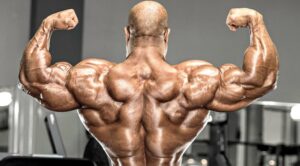Building muscle and increasing strength are common goals for many individuals seeking to improve their physical fitness and overall health. Whether you’re an athlete, a fitness enthusiast, or simply looking to enhance your physique, achieving these goals requires a combination of proper training, nutrition, and recovery.
Achieving a muscular and strong physique is a common goal among fitness enthusiasts. Whether you’re aiming for improved athletic performance, enhanced physique, or overall better health, building muscle and increasing strength is a worthwhile endeavor.
Understanding Muscle Growth and Strength
Muscle growth, also known as hypertrophy, is the process of increasing the size and strength of muscle fibers. “Resistance training, such as weightlifting, is the primary stimulus for muscle growth. When you subject your muscles to resistance beyond their normal capacity, they undergo micro-tears”. Your body then repairs these tears, resulting in larger and stronger muscle fibers.
Strength, on the other hand, is the ability of a muscle to exert force against resistance. It is primarily determined by the number of muscle fibers that can be activated simultaneously and the efficiency of their contraction. Resistance training also enhances strength by improving neuromuscular coordination and increasing the size of muscle fibers.
 Essential Components for Building Muscle and Strength
Essential Components for Building Muscle and Strength
To effectively build muscle and increase strength, you need to incorporate the following key components into your training and lifestyle:
-
Resistance Training: Engaging in regular resistance training is the cornerstone of building muscle and strength. Aim for 2-3 resistance training sessions per week, focusing on major muscle groups such as legs, chest, back, shoulders, and arms.
-
Progressive Overload: To stimulate continuous muscle growth and strength gains, you need to progressively overload your muscles. This means gradually increasing the weight you lift, the number of repetitions, or the frequency of your workouts.
-
Proper Form and Technique: Maintaining proper form and technique during resistance training is crucial to prevent injuries and maximize muscle activation. Seek guidance from a certified trainer if needed.
-
Adequate Nutrition: Providing your body with the necessary nutrients for muscle growth and repair is essential. Consume a balanced diet rich in protein, carbohydrates, and healthy fats.
-
Sufficient Rest: Muscles need adequate rest to recover from training and grow. Aim for 7-8 hours of quality sleep each night.
Check Out Our List Of The Best Supplements For Building Muscle, Shredding Muscle, Recovery, And Great Health, and Wellness Products! Purchase IFBNewsfeed.Org‘s Apparels Here: IFBNewsfeed.Org

 Designing an Effective Resistance Training Program
Designing an Effective Resistance Training Program
An effective resistance training program should incorporate exercises that target all major muscle groups and include a variety of rep ranges and intensities.
-
Compound Exercises: Focus on compound exercises that engage multiple muscle groups simultaneously, such as squats, deadlifts, bench presses, rows, and overhead presses.
-
Rep Range: Aim for a rep range of 6-12 for muscle growth and 3-5 for strength gains.
-
Intensity: Lift a weight that is challenging but allows you to maintain proper form throughout the set.
-
Rest Periods: Allow adequate rest between sets, typically 30-60 seconds for muscle growth and 1-2 minutes for strength training.
Nutrition for Muscle Building and Strength Training
Proper nutrition is essential for fueling muscle growth and repair. Focus on consuming a balanced diet that includes:
-
Protein: Protein provides the building blocks for muscle tissue. Aim for 0.7-1 gram of protein per pound of body weight daily.
-
Carbohydrates: Carbohydrates provide energy for your workouts and replenish muscle glycogen stores. Choose complex carbohydrates from whole grains, fruits, and vegetables.
-
Healthy Fats: Healthy fats, such as those found in avocados, nuts, and seeds, support hormone production and cell growth.
-
Hydration: Stay hydrated throughout the day to support muscle function and recovery.
 Supplements for Building Muscle and Strength
Supplements for Building Muscle and Strength
While a balanced diet should provide most of the nutrients you need, certain supplements can be beneficial for muscle building and strength training:
-
Protein Powder: Protein powder can be a convenient way to increase your protein intake, especially if you struggle to get enough from food sources.
-
Creatine: Creatine is a naturally occurring substance that can enhance muscle energy production and improve strength gains.
-
Branched-Chain Amino Acids (BCAAs): BCAAs can help reduce muscle breakdown and promote recovery after workouts.
Additional Tips for Building Muscle and Strength
Here are some additional tips to enhance your muscle-building and strength-training efforts:
-
Warm-up and Cool-down: Always warm up before your workouts to prepare your muscles and cool down afterward to promote recovery.
-
Track Your Progress: Keep track of your workouts and progress to assess your effectiveness and make adjustments as needed.
-
Seek Professional Guidance: Consider consulting a certified personal trainer or strength coach for personalized advice and programming.
-
Prioritize Sleep: Adequate sleep is crucial for muscle growth and repair. Aim for 7-8 hours of quality sleep each night.
-
Manage Stress: Manage stress levels, as chronic stress can hinder muscle growth and recovery.
-
Stay Consistent: Building muscle and strength takes time and consistency. Stick to your training program
 Wrapping up
Wrapping up
Muscle growth, also known as hypertrophy, refers to the increase in the size of muscle fibers. “This process occurs through a mechanism called muscle protein synthesis, which involves the breakdown and repair of muscle tissue”. When muscles are subjected to resistance training, they experience microscopic tears, which the body then repairs, leading to an increase in muscle fiber size.
Strength, on the other hand, refers to the ability of a muscle to exert force against resistance. “Strength training involves progressively increasing the load on your muscles to stimulate adaptations that enhance their ability to produce force”.
The Role of Resistance Training
Resistance training, also known as strength training, is the primary stimulus for building muscle and increasing strength. “It involves using external resistance, such as dumbbells, barbells, resistance bands, or bodyweight, to challenge your muscles and promote growth”.
More About Muscle Growth and Strength Guide Contents
- Muscle Development: How To Maximize Your “Muscle Growth” And “Physical Strength” By Training Twice Per Day
- Here Are “The Best Lower Body Workouts For Strength, Fat Loss, Muscle Growth, And More”
- The Best “15-Minute Warm-Ups” To Speed Up Muscle Growth, Physical & Mental Strength, And Fast Recovery

- Shop Optimum Nutrition Energy: Anytime & Pre-Workout
- $5.95 Ground Shipping On Any Purchase In The US! – Shop Now!
For More News And Daily Updates, Follow IFBNewsfeed.Org on Facebook, Twitter, and Instagram. Comment, Like, And Share With Everyone Who May Need To Be Updated With The Most Recent Fitness/Bodybuilding/Powerlifting And CrossFit News.







